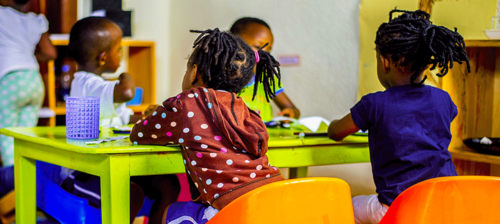
Early Childhood Program
Children ages 3-6 years old begin developing important skills that are fundamental to all learning; concentration, a sense of order, coordination, confidence, and independence. Children have the capacity to learn quickly and almost effortlessly through activities. They are encouraged to be sensorial explorers, learning through the engagement of their senses.
Our classrooms offer a wide variety of hands-on activities and materials designed to meet each child's individual needs and periods of readiness. Students are free to work independently within a structured environment, doing real activities with an intelligent purpose.
The Children’s House
The early childhood classroom, also known as the Children's House, is made up of 24-30 children aged three to six. The multi-age environment gives children the opportunity to learn from others. They receive small group and one-on-one lessons in core subjects. Each student reads with a teacher each day. Special attention is paid to the natural world with observation and care of plants and animals, outdoor play and exploration, and opportunities for gardening.
Language Development
Toddlers are encouraged to use language to express their needs and build connections with others. Creative expression is woven throughout the day through:
Developmental art activities
Music and rhythm exploration
Storytelling and song
Early Childhood Curriculum
Mathematics in Montessori is a concrete-to-abstract approach. Building on sensorial experiences, children take part in mathematical activities that begin with early counting and matching experiences progress towards increasing understanding of number patterns, the four operations, number facts and two and three dimensional shapes.
Mathematics
Language development in Montessori initially focuses on spoken language and vocabulary enrichment. Phonological study leads to writing, reading, and the function of words. Children engage in activities such as songs, games, poems, stories and classified language cards to refine their language skills. The process begins with practical life exercises and sensorial training.
Langauge
Young children are intensely interested in the natural world. They ask questions constantly in order to build a framework to classify the world that surrounds them. The science curriculum at this age takes advantage of the young child’s natural curiosity. It offers concrete exploration that helps build vocabulary and understanding of physical and life sciences.
Science
The goal of the geography curriculum at this level is to introduce geographical concepts through a concrete sensorial approach. We first give the big picture (land, air, and water) and gradually move to details like the names of continents, oceans, or states. An awareness of the physical features of the earth is built through concrete exploration of land/water formations and maps. The study of culture is integrated with Practical Life and strives to provide children with multi-sensory impressions of the people, lands, and cultures of other nations.
Social Sciences
At DIMS, children learn to independently care for themselves and their environment through the exercises of practical life. These activities provide opportunities for the development of concentration, fine and gross muscle coordination, a sense order including an orderly work cycle, independence, and attention to detail. The exercises of practical life support the child's natural development of executive function skills. Thus, the activities of practical life lay the foundation for all other future academic work. Practical life is the starting point for the youngest members of the class. Children continually develop and refine the skills of practical life throughout their time in early childhood classrooms..
Practical Life
Young children are intensely interested in the natural world. They ask questions constantly in order to build a framework to classify the world that surrounds them. The science curriculum at this age takes advantage of the young child’s natural curiosity. It offers concrete exploration that helps build vocabulary and understanding of physical and life sciences.
Sensorial
“The greatest gifts we can give our children are the roots of responsibility and the wings of independence.”

